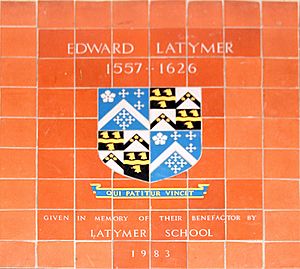Edward Latymer facts for kids

Edward Latymer (born in 1557, died in 1627) was a very rich merchant and an important official in London. He is famous for setting up two well-known schools, Latymer Upper School and The Latymer School, through his will. He also has a connection to Godolphin and Latymer School.
Contents
Edward Latymer's Early Life and Education
Edward Latymer was born in 1557 in Ipswich, England. His father, William Latymer, was a church leader. When Mary I of England became queen, his father's job was at risk because she was Catholic. So, his father moved to Ipswich, near their family lands.
The next year, Elizabeth I of England became queen. Edward's father got his old job back and became the Treasurer of Westminster Abbey. Edward grew up and went to school in Peterborough.
At age fourteen, Edward went to St John's College, Cambridge to study. He left in 1575, but there is no record that he graduated. After this, there is a gap in his life records for 23 years.
How Edward Latymer Became Wealthy
In 1594, Edward Latymer got an important job. He became a Deputy and Clerk to the Receiver General at the High Court. His job was to collect money that people owed.
Over the next 25 years, Edward became very rich from the fees he earned. He made a lot of money from complicated cases about who should inherit property. He bought a large estate called the Manor of Butterwick in Hammersmith.
However, he mostly lived in a place called 'the Signe of the Cocke' in Ramme Alley, in the City of London. In 1615, he bought a small property in Edmonton. This area was a popular country spot at that time.
Edward Latymer's Will and Legacy
Edward Latymer never got married and did not have any children. Because of this, he decided to give most of his money away when he made his will in 1625.
He gave most of his wealth to the people of Hammersmith and the Parish of St Dunstan's. This money helped create what is known today as Latymer Upper School. He also left money for the Parish of Edmonton, which led to The Latymer School.
What His Will Provided
Edward's will provided clothing and education for eight poor boys from Edmonton and eight poor boys from Fulham (which included Hammersmith back then). The boys received special clothing with a red cross on the left sleeve. This clothing was given out twice a year.
The boys were taught to read in English and learned about 'God's true religion' at local schools. They continued their education until they were thirteen years old. Different groups of trustees managed the money and property for the boys in each area.
The main source of money for these gifts came from renting out his property near Pymmes Brook. This property was on the main road to Scotland and later became a famous coaching inn called The Bell. In 1780, it was renamed The Angel. Sadly, this building was taken down in 1968 to make way for the wider North Circular Road.
Edward Latymer's Death and Lasting Impact
Edward Latymer died in 1627. He was buried in a church called St Dunstan-in-the-West in Fleet Street. After he died, some of his relatives tried to challenge his will in court. This caused a seven-year delay before his gifts could actually be used.
Today, several places are named after Edward Latymer. These include Latimer Road in Kensington and the nearby tube station. There are also Latymer Road and Latymer Way in Edmonton.

